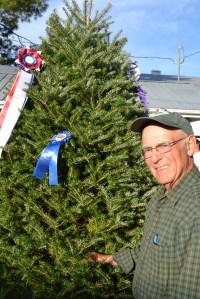FRYEBURG — It’s beginning to look a lot like Christmas in one small section of the Fryeburg Fair where Christmas trees are all the rage and wreath-making demonstrations take place daily.
Behind the dairy barns and the Woodward Show Arena, near the 4-H building, is a clearing displaying the best of Maine’s Christmas trees from about 10 tree farms across the state. Jim Corliss of Newburgh mans a permanent booth where he sells wreath-making supplies and balsam fir and blue spruce saplings to raise money for the Maine Christmas Tree Association’s scholarship fund.
“We usually make enough money to fund two or three scholarships to support college students. Most years we do about $600,” said Corliss, who is also superintendent of the Christmas tree and wreath competitions at the fair.
People stopping at the booth did more than buy trees and supplies, though. They took advantage of the expertise Corliss and other Maine Christmas Tree Association members could offer and asked the questions about growing and caring for trees on their own properties.
“What’s the best way to help this sapling grow and survive?” asked one woman who visited the booth.
“Well, first you buy them,” said veteran tree farmer James LaCasce of Dover-Foxcroft, and owner of Finest Kind Tree Farms. “Then, put a big iron stake beside them, that way when you’re riding with a lawn mower and you hit it, you’ll know it.”
LaCasce, who won the grand prize for one of his trees, also had more serious advice to give.
“Water them and mulch them a couple of inches thick. The biggest danger is the first winter, before the roots have grabbed the soil,” he said.
There were 21 trees submitted for the four different classes of competition at the fair from farms in Hodgdon, Dover-Foxcroft, Newburgh, Bangor, Belfast, Norridgewock, Cornville, Dayton, Denmark and Raymond. The trees are rated by volunteer judges, earning points for several categories, including taper, handle, top, foliage, damage, cleanliness and overall appeal.
Because different people have different ideas of what makes the perfect Christmas tree, judging can be difficult. That’s why Corliss gives judges ranking sheets explaining the categories and breaking them down into more specific criteria for judging.
“It goes by the score sheet, and that’s really important. It’s a very subjective subject, and we try to make it as objective as possible,” Corliss said.
Before Corliss places the ribbons on the trees, he places numbers. The first two days of the fair, visitors to the Christmas tree staging area are invited to vote for their favorite tree in an informal survey. More than 400 people voted during the first two days of the 2015 Fryeburg Fair, according to LaCasce.
“Our growers want to know what people like,” Corliss said.
Several times a day, Corliss offers wreath-making presentations, but he has yet to complete a wreath at the fair.
“I’ve done seven demonstrations in the last two days and I haven’t completed a wreath yet,” he admitted.
Despite that, people who watch the demos learn some valuable information if they’re interested in making their own wreaths. Corliss shows people how to begin and end a wreath and goes over common errors people make while constructing their wreaths. He also goes over materials — where to find them, what to look for and when to gather them.
Corliss planted his first trees at his farm in Newburgh in 1970. He never intended for it to become a passion or a business.
“I thought I’d have a few for my friends and neighbors,” he said. “Now, when we’re overrun with people each year, my daughter says, ‘we sure have a lot of friends and neighbors.’”
Corliss runs Piper Mountain Christmas Trees, and since his retirement from his regular job in 1988, it’s what occupies most of his time. For several years, he was the president of the National Christmas Tree Association and he’s been superintendent of the Fryeburg Fair Christmas tree competitions for decades.
“I don’t even know really how I came to do it. The fella who was doing it before stopped doing it and I probably volunteered,” he said.
Perhaps the most important function of displaying Christmas trees at the Fryeburg Fair is the public relations aspect.
“It keeps real trees in front of the public so they won’t buy artificial,” LaCasce said.
The Fryeburg Fair is the only fair in Maine that the Maine Christmas Tree Association attends, mostly because it would be hard for growers to do more than one when they’re busy pruning and preparing for the upcoming season.
Corliss said that tree farming is much like any other type of farming. The trees are planted and harvested for a purpose. During the seven to eight years it takes for a Christmas tree to grow to the right size, it provides oxygen, wildlife habitat and jobs for kids. When trees are harvested, new trees are planted to take their place.
While trees may seem different to some folks than traditional farm products like food, for example, Corliss offered that they may be more like food than people realize.
“There are those who would tell you that having a beautiful, natural product in the home during a festive time of the year is food for the soul,” he said.


Comments are no longer available on this story